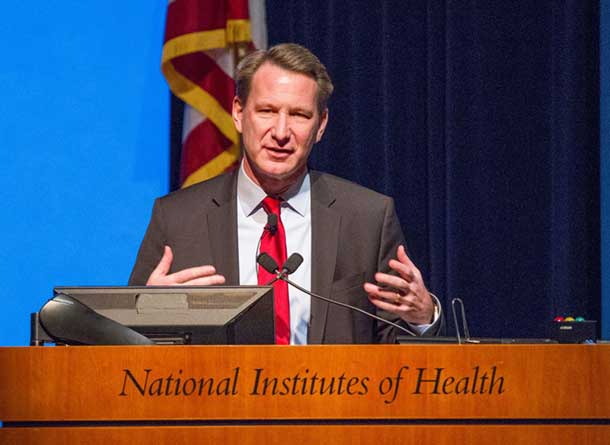
Plans for NCI’s Fiscal Year 2019 Budget
December 18, 2018, by Norman E. Sharpless, M.D.
As I wrote last month, this is an exciting moment in cancer research, marked by innovation, rapid progress, and hope.
As stewards of the nation’s investment in cancer research, NCI's leaders take seriously our responsibility to ensure continued progress across the cancer research continuum and to foster a vibrant research community for the years ahead. In recent weeks, we have made some important decisions regarding fiscal year (FY) 2019 that I would like to share with the broader cancer community.
NCI has benefited from strong bipartisan Congressional support with 5 consecutive years of increases to our annual base appropriations, which are the funds allocated to NCI for standard operations for a given fiscal year. We have also been very fortunate to receive additional funding for the Cancer Moonshot℠.
For FY 2019, which began October 1, Congress provided NCI a base appropriation of $5.74 billion, which represents a $79 million increase from FY 2018, and an additional $400 million for the Cancer Moonshot.
In determining how best to allocate these resources for FY 2019, we have identified three principles to guide our decisions:
The Year Ahead
We will be hosting an online event in January to discuss plans for NCI in 2019. Stay tuned to @theNCIand @NCIDirector on Twitter and facebook.com/cancer.govfor more information on this event.
We must increase support for cancer research through research project grants (RPGs).
NCI has seen a dramatic increase in applications for R01 grants, the most common type of RPG, which are up nearly 50% since 2013. This increase is an indication of the great enthusiasm and innovative spirit across the cancer research community. To harness this energy and continue to attract the brightest minds to cancer research, we must do what we can to meet this increased demand.
NCI has seen a dramatic increase in applications for R01 grants, the most common type of RPG, which are up nearly 50% since 2013. This increase is an indication of the great enthusiasm and innovative spirit across the cancer research community. To harness this energy and continue to attract the brightest minds to cancer research, we must do what we can to meet this increased demand.
How we’ll do it: For FY 2019, we will add approximately $100 million to the pool available to fund RPGs, including both new and continuing awards, to allow us to fund more new grants than last year. This amount is greater than this year’s increase in the regular appropriation, and continuing grant awards—that is, extensions or continuations of existing grants—will be reduced by 3%, to ensure that we can meet the commitment to fund more grants this year than last year.
Additional reductions to certain grant types will be applied as described in NCI’s Funding Policy for RPG Awards FY 2019. These changes will allow us to redistribute money within the RPG pool in order to fund new grants up to and including the 8th percentile. We will continue to leverage all available options to ensure the highest possible success rates, which recently have been approximately 12%. These modest reductions will also allow for some flexibility to pursue emerging opportunities in the field.
We must stay true to the vision of the Cancer Moonshot.
The attention and resources afforded through the Cancer Moonshot have presented a unique opportunity to accelerate progress in the areas identified by the Blue Ribbon Panel and implemented through the Cancer Moonshot implementation teams. NCI leadership is committed to continuing these activities as planned.
How we’ll do it: In that spirit, the full $400 million allocated by Congress for the Cancer Moonshot in FY 2019 will be spent in support of these specific activities. Extensions or continuations of existing grants awarded for Cancer Moonshot research will not be subject to the 3% reduction described above.
We must prioritize training and supporting early-stage investigators (ESIs) to ensure a robust cancer research workforce pipeline.
In FY 2018, we exceeded our goal of funding 25% more ESIs than the previous year. Continued focus on ESIs is essential to fostering innovation, fueling discovery, and strongly supporting the new generation of cancer researchers.
How we’ll do it: Applications from ESIs will be funded up to and including the 14th percentile. In addition, extensions or continuations of existing grants for research training programs (e.g. T-, F- and K-awards) will not be subject to the 3% reduction described above.
We believe these choices make the best possible use of the resources available in support of the cancer research community, but, as is often the case, there are trade-offs.
The realities of the costs of biomedical research are such that the $79 million increase to our base appropriation for FY 2019 is largely consumed by increasing costs: assessments and transfers for NIH and Department of Health and Human Services-wide requirements, potential 2019 pay increases for federal employees, increased training stipends, and the higher total cost than last year for continuing grants awarded in previous years.
In addition to the adjustments to grant funding described above, we are also making internal budget adjustments across NCI. As a result, all NCI divisions, offices, and centers will operate at 95% of FY 2018 levels.
These adjustments to our funding plans are both responsible and strategic, and will ensure that we are able to pursue emerging scientific opportunities in cancer research. We anticipate sharing more about these opportunities in the months ahead. No matter what fiscal climate we face, NCI will strive to commit the resources necessary to ensure continued and rapid progress.
I believe we have another bright year ahead of us, in which we can continue to make meaningful advances in understanding cancer and its prevention, detection, treatment, and survivorship.























.png)











No hay comentarios:
Publicar un comentario